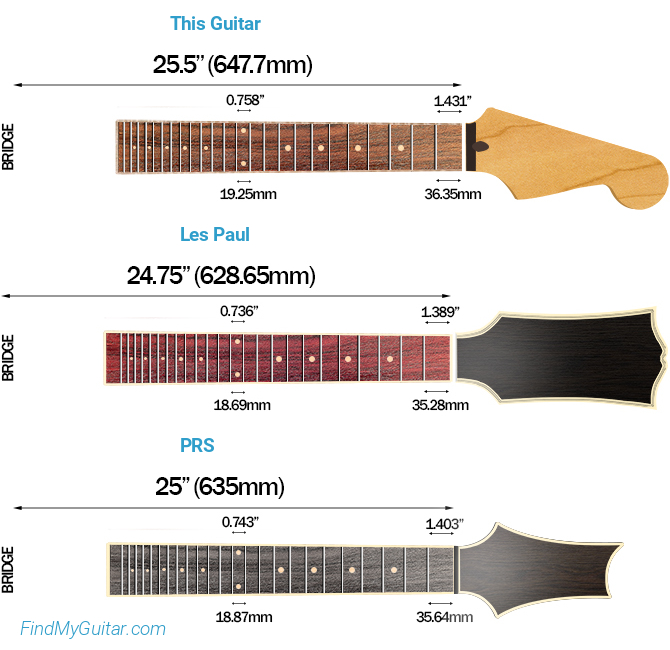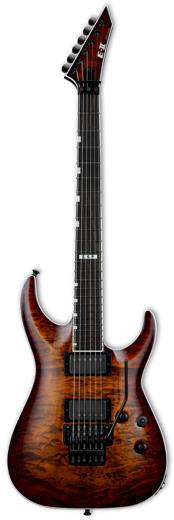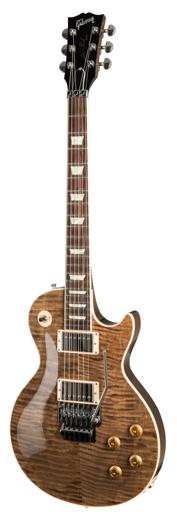ESP E-II Horizon FR-II Review & Prices
- From ESP E-II's 2021 Horizon series
- Made in Japan
- 6 strings
- 25.5"'' scale
- 12" Fretboard Radius
- Quilted Maple top
- Mahogany body
- 3pc Maple neck
- Ebony fretboard
- Bridge pickup: EMG 57TW (Humbucker/Active)
- Neck pickup: EMG 66TW (Humbucker/Active)
- 1 volume and 1 tone Dome knobs
- 3-way Switch
- Floyd Rose Original bridge
- Thin U Neck-Through neck
- 24 XL Jumbo frets
- Gotoh Locking tuners
- Compare Specs >
Our Scores and Tone Evaluation
- Heavy Metal
- Hard Rock
- Jazz
- Blues
- Funk
- Country
ESP E-II Horizon FR-II
- Locking Tuners
- Made in Japan
- Expensive Wood
- Locking Nut
- Top Brand Pickups
- Neck-Through Build
- Coil Split Pickups
- Tremolo
- Retainer Bar
- Strap Lock
- Cheap Fret Wire (NS)
- No Weight Relief
- No Luminescent Inlay
- No Compound Radius Fretboard
- No 21:1 Tuner Ratio
Price Overview
Its average competitor's price is $3000, which means that the ESP E-II Horizon FR-II is around 3% cheaper than the competition. This takes into account all instruments of the same category in our database with 6 strings and Double Locking bridge that are made in Japan.
These are affiliate links. We may earn a fee if you purchase after clicking. These prices are prone to error. Make sure you're buying the right product after clicking on a link from our site. We are not liable if you buy the wrong product after following these links. As an Amazon Associate site we earn from qualifying purchases.
Videos





Your feedback
Not all instruments are created equally. That's why it's important to have different opinions. Here's what our users who have played this instrument say. If you've played it before, help others by voting below!
Weight
VoteTuning stability
VoteNeck speed (thickness)
VoteNeck access to high frets
VoteNeck profile shape
VoteFret edges
VotePickups noise
VotePickups power
VoteIs it Easy to Play?
The ESP E-II Horizon FR-II meets 5 out of our 8 criteria items for beginner friendliness, which means that it's a good guitar to start with as a complete beginner. This takes into account the type of frets, scale length, nut width, bridge type, fretboard radius, and neck profile to determine the easiest combination for new players to get used to.
New Player Friendliness
ESP E-II Horizon FR-II- Comfortable shape
- Locking tuners
- Tall frets
- Narrow nut
- Comfortable neck
- Comfortable fretboard
- Short scale
- Easy-to-use bridge
Hand Size Comfortability
After taking into account the neck profile, scale size, fretboard radius, and nut width, we can conclude that the ESP E-II Horizon FR-II's construction favors people with relatively small hands.
Nevertheless, this comes down in the end to personal preference. Make sure you test this guitar—or another one with similar characteristics—before buying.
Scale Length
Scale length is the distance the strings will span between the bridge and the nut. It can tell you a lot about the overall playability and tone of the instrument. A longer scale length means longer distance between frets, brighter tone and more string tension—which means lower action, but more difficult bending of the strings.
Here's the ESP E-II Horizon FR-II's 25.5" scale length compared to other common sizes:

This is the same scale length used in Stratocaster guitars, and it's one of the main reasons they have such a bright sound. It's considered a long scale when compared to most non-baritone guitars.
Since the distance between bridge and nut is relatively long, you'll need to give the strings more tension to get them in tune. This higher tension will allow for a couple of things. First, you can get a lower action (get the strings closer to the fretboard) because the strings won't 'wiggle' too much when pluck and won't cause fret buzz. This can allow you to use lower tunings without increasing your string gauge, and it will make it easier to press down the strings fast.
However, the frets will also have a wider separation between each other, which can make it harder to play, especially if you got small hands. The higher tension will also make the strings feel stiffer, so bending will require more strength.
Neck Profile

The neck profile tells you the thickness (neck depth) and shape in cross section. Every difference will completely change the feeling and comfortability of the neck. This is a highly subjective thing, but most players indeed prefer certain types of necks (like Cs and Ds) because they feel nice in most hands.
The ESP E-II Horizon FR-II's neck thickness is approximately 0.787'' (20mm) at the first fret, and 0.866'' (22mm) at the twelfth.
These measurements were taken either from the official ESP E-II website, or, in case this information wasn't provided, by researching multiple online marketplaces and forums where owners of this model have posted their measurements.
It has a U type neck. This shape usually has more 'shoulders' than a C neck. It's great for guitarists who love the feel of a vintage neck. Most of them are thick, which makes it better for people with big hands. However, some of them can be thin like a C neck but with more mass to the sides for a better grip.
Fretboard Radius
When it comes to fingerboard radius, personal preference will dictate which one is better for you. However, most people seem to agree that a more curved (lower) radius will make it easier to play chords while a less curved (higher) radius is better for soloing and bending.
The ESP E-II Horizon FR-II has a 12" fingerboard radius.
Here's an image comparing this fretboard radius to other popular choices:

This is the same radius that Gibson uses in most of their guitars. When compare to the other popular radius of Fender Stratocasters, you can see that it's a lot flatter. Guitars with this radius are usually made to bring a good balance between single-note and chord playing.
Compound radius fingerboards give the best of both worlds. Unfortunately, the ESP E-II Horizon FR-II has the same radius across the board.
Playability compared to main competitors
Nut Width

The ESP E-II Horizon FR-II has a nut width of 42mm (1.654''). This is considered a narrow width for a 6-string guitar. This means that this guitar will have a narrower string separation at the nut, which will affect your fretting hand.
If you are a player with big hands, you might find it difficult to play chords without muting strings. However, this is good for players who have smaller hands, as it will allow them to reach each string more easily at the nut.
Frets
The ESP E-II Horizon FR-II has 24 frets. A lot of people mistakenly believe that having more frets will always be better because it gives you a higher octave. This is certainly an advantage, but there's also a disadvantage to this.
Since the fretboard will be longer, the neck pickup will need to be placed closer to the bridge. And as you may know, the further away the neck pickup is from the bridge, the warmer it sounds. This means you'll have a brighter-sounding neck pickup when using a 24-fret guitar, even if you use the same pickup on a 22-fret guitar.
It comes with nickel silver frets, so they won't last as long as stainless steel frets. If you use your instrument a lot, you might need to replace the frets after a few years. But this is unlikely as most people change instruments before this happens.
Fret Size

Finally, let's talk about fret size. Some people prefer tall frets because it's easier to press the strings and perform bends since there's less friction against the fretboard. On the other hand, some people like shorter frets because they like to touch the fretboard when playing, or because they got heavy hands and tend to press too much on the string and alter the of the note pitch accidently.
The ESP E-II Horizon FR-II's frets are XL Jumbo size. These are extra-large frets, which are perfect for people who truly want the least resistance for techniques like vibrato, bending, tapping, and just playing fast in general. You won't be able to feel the fretboard with these frets, so if you press too hard you'll get the notes out of pitch. It might take a while to get used to them because of this.
Playability Score
Tone Analysis
Wood will have little influence in the final tone of an electric guitar or bass. Instead, the hardware, especially the pickups, will be the most important thing to look at. Bur first, let's see the quality of the wood.
Wood



Mahogany Body: This is the type of wood found in many top-of-the-line guitars, so that's a positive point for the build quality. This red-looking wood Mahogany is found in Africa and Central America and has great sustain and a warm tone due to its high density. The downside about this type of wood is that it's relatively heavy.
Maple Neck: This is one of the most popular types of wood used in all kinds of guitars. It's heavy, strong and compact, which makes it great for necks. However, it's also used for fretboards, bodies and tops due to its light color, resistance and beautiful patterns. When it comes to tone, it highlights the mid and high frequencies.
Ebony Fretboard: This is one of the most expensive woods there is, which is why it's mostly used for fretboards. It is dense, heavy, highly resistant and comes in a really dark color that gives any guitar a classy touch. Tone wise, it helps the high side of the spectrum and provides good sustain.
Pickups
This guitar comes with pickups from one of the top brands: EMG. So you can expect well built pickups with great sound that shouldn't need an upgrade anytime soon.
These are active pickups, so you can expect a lot of output with a highly compressed signal that will give your tones more distortion while retaining a clear, defined sound, which is what many Heavy Metal players need. However, they have the disadvantage of sometimes lacking a fully clean sound when playing without distortion.
The ESP E-II Horizon FR-II's configuration is HH. With this pickup combination, you'll get warmer tones and more output than using single coils. Humbucker pickups cancel the noise that single-coil suffer from, which also results in a warmer tone. This pickup combination isn't only for high-gain music like Hard Rock or Heavy Metal. Their warmness is also popular for Jazz, Indie, R&B, Blues and more.
More with the same pickups
Versatility
It comes with the popular 3-way switch that is present in most guitars. For more versatility, players tend to prefer a 5-way switch, although it all depends on what you want to use your guitar for.
It has a Coil Split option. It allows you to 'split' or turn off pickup coils to get even more tones in combination with the pickup selector. When used with humbucker pickups, it'll reduce the output and increase their clarity, turning them essentially into single-coil pickups.
Diagram

What music genre is it good for?
As a 6 strings, Solid Body guitar with HH configuration and Active pickups, we'd recommend it for genres like Heavy Metal or similar. However, you can use almost any guitar for any genre. This is just the typical type of music for this particular one.
Sound Score
Build Quality Analysis
Country of Origin
Knowing where the instrument is produced is a good way to know how well it's built. Some manufacturing countries are known for having higher quality standards. For example, most expensive instruments are made in the US or Japan, but there are some exceptionally great countries—like South Korea—that are building a good reputation.
The ESP E-II Horizon FR-II is made in Japan. You should expect a high-quality guitar with excellent quality control. It can be compared to guitars made in the US, which is why they're also expensive.
Bridge
Floyd Rose Original: With this type of tremolo bridge, you'll be able to perform dive bombs and pinch harmonics without getting out of tune. This type of bridge gives you the best versatility, but it also makes it harder to set up your guitar correctly, especially when changing your strings.
Tuners
The ESP E-II Horizon FR-II comes with locking tuners, which helps with tuning stability and makes changing strings a lot faster and easier. As long as they're high quality, these are the best tuning machines you can have. The only disadvantage is that they are a bit heavier than normal tuners.
Nut Material
Another important thing to analyze is the nut material, as it's one of the most important aspects that can affect the sound and playability of your guitar. A well-cut nut will make sure it stays in tune and will make it more comfortable to play.
In this case, the ESP E-II Horizon FR-II has a Locking nut. Instead of the typical nut, this nut locks the strings in place and will make them stay in tune even after heavy tremolo use. This type of nut provides the best tune stability, but they also make the guitar more expensive.
It also comes with a retainer bar for the locking nut, which is a helpful addition. Without it, the strings would change pitch once you lock down the nut, so you'd have to make more micro-adjustments at the bridge to tune it correctly.
Neck Joint
The neck joint is the part where the neck of the guitar meets the body. There are three main techniques to attach both parts together: Set-In, Bolt-On and Neck-Through. The latter two provide different advantages, although neck-throughs are the most expensive.
This guitar has a Neck-Through neck joint. Many people believe a neck-through build delivers the best sustain because some of the vibrations from the neck aren't lost like with other neck joints. However, no one has been able to prove this. What we know is that a neck-through build is usually the most comfortable when playing the upper frets because there's nothing on your way at the neck-body joint.
Build Quality Score
All Specs
ESP E-II Horizon FR-IIMore Popular Comparisons With This Guitar
User Reviews
Help others by sharing your opinion about this guitar. Note: to avoid spam, your review will be submitted for approval before appearing here.














